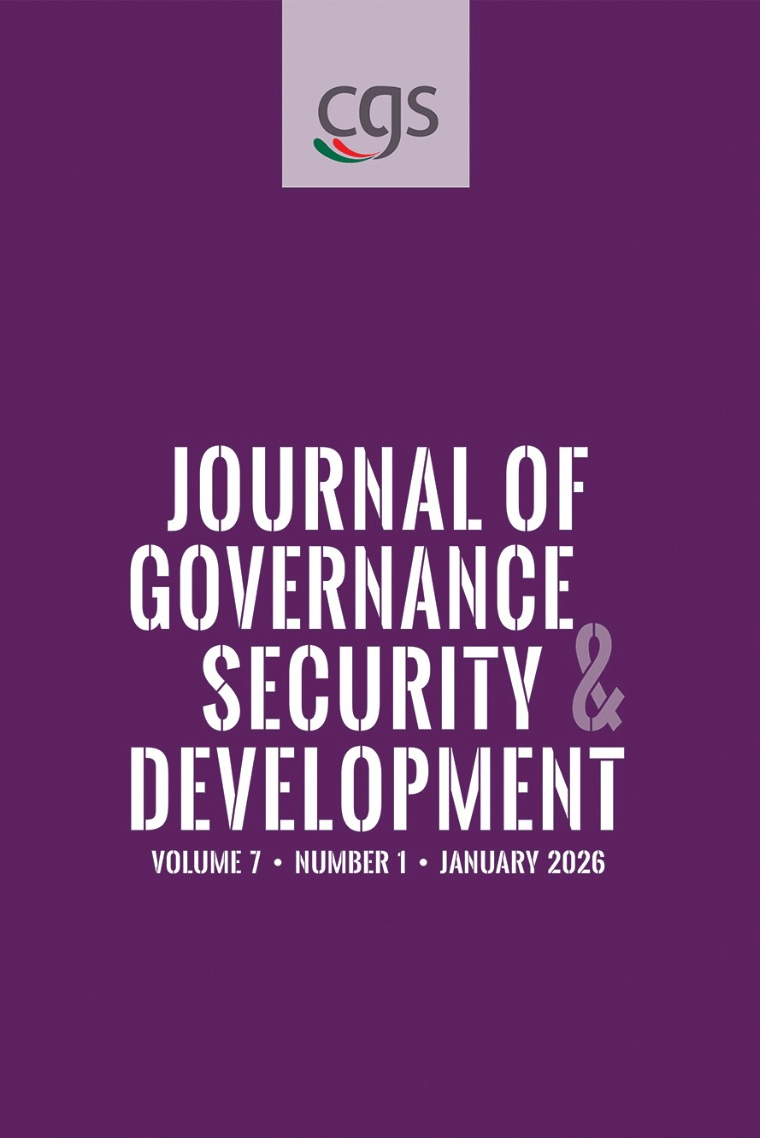Journal Reference
Volume 6 | Number 1-2
Online Version: ISSN No: 2708-2490
Print Version: ISSN No: 2709-0590
Price: BDT: 750.00, USD: 25.00
Publish Date: 01, July 2025
Article:
Samimuzzaman
Reference
References
Adhikari, D. (2020). ‘Nepal Ruling Party Split over US Aid Threat to China Relations.’Nikkei Asia. Retrieved from https://asia.nikkei.com/Politics/International-relations/Nepal-ruling-party-split-over-US-aid-threat-to-China-relations. (Accessed: 5 June 2022).
Anderson, A. & Ayres, A. (2015). Economics of Influence: China and India in South AsiaCouncil on Foreign Relations, CRF. Retrieved fromhttps://www.cfr.org/expert-brief/economics-influence-china-and-india-south-asia (Accessed: 1 October 2022).
Andreopoulis, M. (2023). China’s border talks with Bhutan are aimed at India.Foreign Policy. https://foreignpolicy.com/2023/07/18/china-bhutan-border-talks-india-dispute-security/. (Accessed: 10 April 2025).
Anwar, A. (2019). China’s Growing Engagement in South Asia: Challenges for the US. Pacific Forum, Issues & Insights, Vol. 19, pp. 1-11.
Anwar, A. (2022, August 18). China-Bangladesh relations: A three-way balance between China, India and the US, MERICS. Retrieved from https://merics.org/en/china-bangladesh-relations-three-way-balance-between-china-india-and-us. (Accessed: 13 September 2022).
Bhogal, P. (2016). India’s foreign aid to South Asia, ORF, 11 November. Retrieved from https://www.orfonline.org/research/indias-foreign-aid-to-south-asia/. (Accessed: 1 October 2022).
Buzan, B. (2008). The Globalization of World Politics: An Introduction to International Relations. Oxford University Press.
Campbell, I., Wheeler, T., Attree, L. Butler, D. M. & Mariani, B. (2012). China and Conflict-Affected states: Between Principle and Pragmatism. London: Saferworld. https://www.ecosonline.org/reports/2012/Saferworld_ China_ and_ conflict-affected_states.pdf
Chansoria, M. (2023), All Politics is Global] Bhutan: Important Clues to its China Stance Can Be Found in History, Japan Forward. Retrieved from https://japan-forward.com/all-politics-is-global-bhutan-important-clues-to-its-china-stance-can-be-found-in-history/. (Accessed: 13 September 2023).
Dasgupta, S. (2017). ‘China trying to create confusion before elections in Bhutan, building its soft power in the kingdom, say experts, Times of India. Retrieved from https://timesofindia.indiatimes.com/world/china/china-trying-to-create-confusion-before-elections-in-bhutan-building-its-soft-power-in-the-kingdom-say-experts/articleshow/59506167.cms. (Accessed: 1 October 2022).
Gilpin, R. (1981). War and Change in World Politics, Cambridge University Press, Cambridge.
Hazarika, O.B. & Mishra, V. (2016). Soft Power Contestation between India and China in South Asia, Indian Foreign Affairs Journal, Vol. 11, No. 2, pp. 139-152. Retrieved from https://www.jstor.org/stable/45341093. (Accessed: 13 May 2020).
Hein, P. (2017), Riding with the Devils: China’s Role in the Cambodian and Sri Lankan Conflicts, India Quarterly, Vol. 73, No. 1, pp. 78, 88.
Heywood, A. (2014). Global Politics. Palgrave Macmillan.
IRI. (2021). China’S Authoritarian Influence and The Democratic Response: Country Case Studies from Nepal, Kenya, Montenegro, Panama, Georgia and Greece, International Republican Institute, pp. 9-16.
Junayd, M. (2023). Maldives presidential run-off pits pro-India, pro-China figures, Maldives presidential run-off pits pro-India, pro-China figures, Reuters. Retrieved fromhttps://www.reuters.com/world/asia-pacific/maldives-presidential-run-off-pits-pro-india-pro-china-figures-2023-09-30/. (Accessed: 10 December 2023).
Kang, D. C. (2007). China rising: Peace, power, and order in East Asia, Columbia University Press.
Khan, B. (2008). India and the Making of a Hegemon, Australian Institute of Policy and Science, Vol. 80, No. 1, p. 35. Retrieved fromhttps://www.jstor.org/stable/20638532. (Accessed: 20 December 2020).
Khondoker, R. & Zaman, R. U. (2020). Coping with the Dragon: Small States of South Asia and Their Foreign Policy Responses to China's Rise. StosunkiMiędzynarodowe-International Relations, Vol. 56, No. 2, pp. 85-110.
Kudrati, M. (2022). ‘Bangladesh Highest Recipient Of Indian Lines Of Credit Since 2016, BOOM. Retrieved from https://www.boomlive.in/explainers/bangladesh-highest-recipient-of-indian-lines-of-credit-since-2016-17268. (Accessed: 15 April 2022).
Lai, D. (2011). The Power Transition Theory, in the Report: The United States and China in Power Transition Theory, Strategic Studies Institute, US Army War College.
Lai, F. (2020). China’s economic influence in Afghanistan in a Belt & Road context, Asia Power Watch. Retrieved from https://asiapowerwatch.com/chinas-economic-influence-in-afghanistan-in-a-belt-road-context/. (Accessed: 1 February 2022).
Lal, N. (2022). India wary of China setting up Bangladesh missile maintenance hub, Nikkei Asia. Retrieved from https://asia.nikkei.com/Politics/International-relations/India-wary-of-China-setting-up-Bangladesh-missile-maintenance-hub. (Accessed: 1 December 2022).
Larson, D. W. (2019). Chinese foreign policy in transition: Power, principle, and pragmatism in a post-hegemonic world, Brookings Institution Press, p. 47.
Mearsheimer, J. J. (2001). The Tragedy of Great Power Politics, Norton, New York, NY,pp. 4, 6, 10-11, 18, 27, 30-32, 43, 51-53, 75, 142-143, 266-267, 334, 362, 382, 401-402.
Mehta, R. (2010). Lost Victory: The Rise &Fall of LTTE Supremo, V. Prabhakaran, Pentagon Press.
Mendis, P. (2022). Will China subdue the United States without a fight to dominate the Indian Ocean?, Harvard International Review, 11 July. https://hir.harvard.edu/president-xis-art-of-war-in-sri-lanka/. (Accessed: 10 April 2025).
Mitra, R. (2022). The China-India Cold War in Maldives, The Diplomat. Retrieved from https://thediplomat.com/2022/01/the-china-india-cold-war-in-maldives/ (Accessed: 1 October 2022).
Muni, S. D. (1984). Bhutan Steps Out. The World Today, 40(12): 514–520. http://www.jstor.org/stable/40395575
Naomi, S. S. (2023). Bangladesh Foreign Policy Approach Should Shift to Multi-alignment, Institute for Security & Development Policy. Retrieved from https://www.isdp.eu/bangladesh-foreign-policy-approach-should-shift-to-multi-alignment/. (Accessed: 1 October 2022).
Nga, L.T. H& Thuong, L. T.. (2021). India–China competition in South Asia under Prime Minister Narendra Modi’s administration. The Journal of Indian and Asian Studies, 2(1): 2150001. https://www.worldscientific.com/doi/epdf/10.1142/S2717541321500017.
Organski, AFK. (1958). World Politics, New York: Alfred A. Knopf.
Paul, T. V. (2018). When balance of power meets globalization: China, India and the small states of South Asia, Politics, Vol. 39, No. 1, pp. 50–63. Retrieved from (https://doi.org/10.1177/0263395718779930). (Accessed: 18 February 2021).
PTI. (2020). Maldives thanks India for $250 million support amid COVID-19 pandemic, The Hindu, Retrieved from https://www.thehindu.com/news/national/maldives-thanks-india-for-250-million-support-amid-covid-19-pandemic/article32732746.ece. (Accessed: 1 October 2021).
PTI. (2021). Bangladesh to import defence items from India under USD 500 mn Line of Credit, India News, Indian Express, Retrieved from https://indianexpress.com/article/india/bangladesh-import-defence-items-from-india-under-usd-500-mn-line-of-credit-7676037/. (Accessed: 18 January 2022).
PTI. (2022). ‘Pakistan, China step up defence cooperation, reaffirm ‘strategic partnership in challenging times’, India TV, Retrieved from https://www.indiatvnews.com/news/world/pakistan-china-step-up-defence-cooperation-reaffirm-strategic-partnership-in-challenging-times-2022-06-12-784100. (Accessed: 18 January 2022).
Ranjan, A. & Zheng, H. (2022). China’s Diplomatic Investments in South Asia, NUS Institute of South Asian Studies (ISAS). Retrieved from https://www.isas.nus.edu.sg/papers/chinas-diplomatic-investments-in-south-asia/. (Accessed: 1 October 2022).
Rosenau, J. N. (1969). International Politics and Foreign Politics, the Free Press, New York, NY.
Rothstein, R. L. (1968). Alliances and Small Powers, Columbia University Press, New York, NY, P. 29.
Safdar, T. M. (2021). The Local Roots of Chinese Engagement in Pakistan, Carnegie Endowment for International Peace.
Saklani, U. &Tortajada, C. (2016). The China factor in India–Bhutan relations, East Asia Forum. Retrieved from https://www.eastasiaforum.org/2016/10/15/the-china-factor-in-india-bhutan-relations/. (Accessed: 1 October 2022).
Samimuzzaman. (2022). How do South Asiaʼs the small states behave in the rise of Asiaʼspower(s)?,Journal on Public Affairs, 18(1):135-160. DOI:10.20776/S18814859-18-1-P135. (Accessed: 3 October 2022).
Samimuzzaman. (2024). Balancing Acts and Proximity Relations: Small Statesʼ Responses to China-India Hegemonic Competition in South Asia, Journal on Public Affairs, 20(1): 106-140. DOI:10.20776/S18814859-20-1-P106. (Accessed: 7 October 2024).
Sen, A. A. (2020). India's role in the context of the international political and security system as a regional hegemony in South Asia.International Journal of Science and Society, 2(2): 104-109. https://doi.org/10.54783/ijsoc.v2i2.100. (Accessed: 23 October 2020).
Shahiduzzaman, M. & Islam, M. S. (2020). Great power politics and small states: Bangladesh and its neighbors.Asian Journal of Political Science, 28(1): 73-91.
Shivamurthy, A. G. (2023). In the Maldives, Domestic Politics is Causing China to Lose Ground.South Asian Voices. https://southasianvoices.org/in-the-maldives-domestic-politics-is-causing-china-to-lose-ground/. (Accessed: 12 December 2023).
Shivamurthy, A. G. ed. (2022). India-China competition: Perspectives from the neighbourhood.ORF Special Report, 197. Observer Research Foundation. https://www.orfonline.org/public/uploads/posts/pdf/20230413185420.pdf
Sridharan, E. (2011). International relations theory and South Asia: Security, political economy, domestic politics, identities, and images'.In E. Sridharan (ed.),International Relations Theory and South Asia: Security, Political Economy, Domestic Politics, Identities, and Images Vol. 1. Oxford University Press.
Standish, R. & Khattak, D. (2021). Pakistani Prime Minister defends China's political model and ‘All-Weather Friendship’ with Beijing, Radio Free Europe Radio Liberty. https://www.rferl.org/a/pakistan-imran-khan-china/31356140.html. (Accessed: 17 January 2022).
Star Business Report. (2022). Bangladesh’s exports to India to grow record $2 billion by FY22: FBCCI, The Daily Star, 18 January. https://www.thedailystar.net/business/export/news/bangladeshs-exports-india-grow-record-2-billion-fy22-fbcci-2941941. (Accessed: 1 October 2022).
The Economic Times. (2020). China uses corrupt leaders to make inroads into economically weaker countries Like Nepal: Report, The Economic Times, 13 July.https://economictimes.indiatimes.com/news/defence/china-uses-corrupt-leaders-to-make-inroads-into-economically-weaker-countries-like-nepal-report/articleshow/76932453.cms?from=mdr. (Accessed: 9 June 2021).
The International Crisis Group. (2022). Afghanistan's Security Challenges Under Taliban, The International Crisis Group. https://www.crisisgroup.org/asia/south-sia/afghanistan/afghanistans-securitychallenges-under-taliban. (Accessed: 8 September 2022).
Trivedi, A. (2021). India’s soft power, investments in Afghanistan lead to diplomatic dead end.Business Standard, 30 August https://www.business-standard.com/article/international/india-s-soft-power-investments-in-afghanistan-lead-to-diplomatic-dead-end-121083000047_1.html. (Accessed: 10 April 2022).
Waltz, K. (1990). Realist Thought and Neorealist Theory, Journal of International Affairs, Vol. 44, No. 1, pp. 26, 32-34.
Waltz, K. (1979). Theory of International Politics, Addison-Wesley.
Walt, S. M. (1987). The Origins of Alliaces, Cornell University Press.
Werner, S. & Kugler, J. (1996). Parity and War: Evaluations and Extensions of ‘The War Ledger.’ Ann Arbor: University of Michigan Press.


